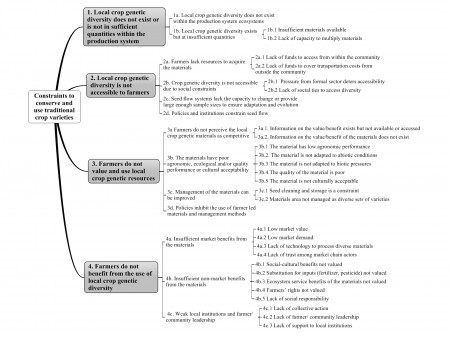 A while back we blogged a couple of times about plant micro-reserves in Crete, including one for an endemic crop wild relative. That work is linked to a similar project in Cyprus, and although no CWRs are on its priority list of species, I suspect some of the target habitats may contain some. I mention all this because the Cyprus project happens to have a Facebook page (which is interesting in itself), on which photographs have just been published of the setting up of notice boards at one of the micro-sites. ((The photo of Cape Grecko on Cyprus is reproduced from TeryKats’s Flickr page under a Creative Commons license.))
A while back we blogged a couple of times about plant micro-reserves in Crete, including one for an endemic crop wild relative. That work is linked to a similar project in Cyprus, and although no CWRs are on its priority list of species, I suspect some of the target habitats may contain some. I mention all this because the Cyprus project happens to have a Facebook page (which is interesting in itself), on which photographs have just been published of the setting up of notice boards at one of the micro-sites. ((The photo of Cape Grecko on Cyprus is reproduced from TeryKats’s Flickr page under a Creative Commons license.))
How to give agrobiodiversity an even break
![]() Our friends at Bioversity have meta-done it again. After a milestone contribution a few years ago on the patterns of landrace diversity in farmers’ fields, now arrives a monumental review of the kinds of things that can be done to keep it there. ((Jarvis, D., Hodgkin, T., Sthapit, B., Fadda, C., & Lopez-Noriega, I. (2011). An Heuristic Framework for Identifying Multiple Ways of Supporting the Conservation and Use of Traditional Crop Varieties within the Agricultural Production System Critical Reviews in Plant Sciences, 30 (1), 125-176 DOI: 10.1080/07352689.2011.554358)) It comes as part of a special issue of Critical Reviews in Plant Sciences entitled “Towards a More Sustainable Agriculture.”
Our friends at Bioversity have meta-done it again. After a milestone contribution a few years ago on the patterns of landrace diversity in farmers’ fields, now arrives a monumental review of the kinds of things that can be done to keep it there. ((Jarvis, D., Hodgkin, T., Sthapit, B., Fadda, C., & Lopez-Noriega, I. (2011). An Heuristic Framework for Identifying Multiple Ways of Supporting the Conservation and Use of Traditional Crop Varieties within the Agricultural Production System Critical Reviews in Plant Sciences, 30 (1), 125-176 DOI: 10.1080/07352689.2011.554358)) It comes as part of a special issue of Critical Reviews in Plant Sciences entitled “Towards a More Sustainable Agriculture.”
It’s a long and complex article and impossible to do full justice to here, but the motivation behind it is simple enough: “to understand better the nature and contribution of traditional varieties to the production strategies of rural communities … and the ways in which they are maintained and managed.” That landraces still make such a contribution, despite expectations to the contrary in many quarters, ((Not least much of the rest of the CG system, one is tempted to say.)) is undeniable. As the authors admit, there is a lively ongoing debate about whether this can, or indeed should, continue. The superior adaptation of landraces to marginal conditions, the stability of their performance over time, the socio-economic conditions of small-scale farmers, and growing concerns about reducing agriculture’s dependence on inputs would all seem to point to a continuing, significant role in livelihoods strategies, at least in specific situations. But if so, why do they need help, as the authors also concede?
The problem is that lots of external factors work against landraces being all they can be, from dysfunctional seed systems to short-termist government policies. The diagram in Fig. 1 makes this clear (clearer still if you click on it):
The paper is really about what can be done to make it a more even playing field for landraces, by overcoming these multitudinous constraints. To that end its centrepiece, Table 1, is a huge list of the sorts of specific actions that have been undertaken around the world over the years in support of landrace management on farm.
So, for example, re-introducing landraces from a genebank (be it international or community), based on local adaptation and farmer preferences, would address constraints 1a and 2a, which have to do with the lack of sufficient planting material. Getting breeding programmes to use more landraces and farmer selections would be great for 2d, 3a, 3b, 3c, 3d, 4a, 4b and 4c (which incidentally seems pretty good value for money). Enabling farmer groups to develop a marketing strategy for landrace products would take care of 3a, 4a and 4c. And so on, and on, for 16 pages. The list of potential interventions is nothing if not exhaustive, and each is in turn exhaustively documented with references.
This is, like the previous review, a tour-de-force. If anything is missing from the discussion, it is perhaps a sense of what the best bets might be. That is, having identified a particular constraint or set of constraints, what are the things that are likely to be most effective in different contexts, for different crops? For that, a rearrangement of Table 1 summarizing and prioritizing interventions for each constraint would have been a useful start. Thus, if you find specific constraint X, you can do A, B and C, and B is what has worked best in the past in similar situations. Another area that could have been explored in more detail is how interventions work — or fail to work — when implemented together. But all this would be no more that tinkering with the masses of data that have been put together, which is perhaps already going on in Bioversity’s Maccarese eyrie.
The next major analytical step, surely, is to work out, or document if the information is already available, what these interventions actually cost. That would allow some calculation of possible returns on investment. Whether, and to what extent, any of the things that are so comprehensively described in this paper are ever done on a large scale in support of landrace conservation and use on farm will probably in the end be down to that. After all, those pushing the “alternatives” have already done their sums.
Brainfood: Diet, Olives, Beef, Shade trees, Tree regeneration, Poverty, Weeds, Birds
- Farming for balanced nutrition: an agricultural approach to addressing micronutrient deficiency among the vulnerable poor in Africa. Dietary diversity is a good idea for many reasons.
- Cultivar characterization of Aegean olive oils with respect to their volatile compounds. Only two varieties, and they do differ.
- Beef Authentication and Retrospective Dietary Verification Using Stable Isotope Ratio Analysis of Bovine Muscle and Tail Hair. Back40 has an explanation of why this is more important than all the certification schemes in the world.
- Promoting native trees in shade coffee plantations of southern India: comparison of growth rates with the exotic Grevillea robusta. Some native species might be able to compete, more research needed.
- Regeneration of Vitellaria paradoxa and Parkia biglobosa in a parkland in Southern Burkina Faso. Vitellaria doing better, possibly because farmers are overharvesting Parkia seeds.
- Defining the poor by the rural communities of Burkina Faso: implications for the development of sustainable parkland management. It’s complicated.
- Does soil biota benefit from organic farming in complex vs. simple landscapes? Organic farming increases weed diversity. No word on what it does for birds, but…
- Species richness and composition of bird communities in various field margins of Poland. Some types of field margins are better than others. No word on what they do for weeds.
Brainfood: Biotechnology, Pollinators, Mulberries, Rice blast, Locavores, Roselle, Cassava, Protected areas, Traditional vegetables, Vitis, European diversity
- Agricultural biotechnology for crop improvement in a variable climate: hope or hype? Your guess is as good as mine.
- Pollinator insects benefit from rotational fallows. They do indeed.
- Biological and productive characteristics of silkworm mulberry varieties of different ploidy and their use for raising silkworms in different seasons. Amazing; more silk faster from polyploid mulberries.
- Mapping quantitative trait loci conferring blast resistance in upland indica rice (Oryza sativa L.). They’re there.
- Food relocalization for environmental sustainability in Cumbria. Fair enough, but what, actually, are the locavores going to eat?
- Relationships among twelve genotypes of roselle (Hibiscus sabdariffa L.) cultivated in western Mexico. Twelve genotypes split into two groups, could be important for breeding and production.
- Variation in qualitative and quantitative traits of cassava germplasm from selected national breeding programmes in sub-Saharan Africa. There is some, but not for everything.
- Global protected area impacts. There are some, but not everywhere.
- Diversity, geographical, and consumption patterns of traditional vegetables in sociolinguistic communities in Benin: Implications for domestication and utilization. 245 species, only 19% cultivated, with big differences among ethnic groups and geographical areas. Research and promotion needs identified.
- Observed trends in winegrape maturity in Australia. 1.7 days earlier per year for 1993–2009, 0.8 days earlier per year for 1985–2009.
- Still a lot of diversity out there, Europe edition: common bean in Sicily, melons near Madrid.
Nibbles: Plectranthus, Roads, Fast food, Dog food, Hybrid rice, Mapping climate change, Turf, Cassava, iPhone app, Zizania, Rice
- Livingstone potato (Plectranthus) on the menu in Burundi. Yeah but what does it taste like?
- The world’s roads mapped. About time too.
- The world’s convenience food made better. Maybe.
- Dog cooking pot from ancient China. Woof. Via.
- Hybrid rice backfires. Via.
- Mapping the impacts of climate change. Only country level though.
- Native lawns better. But are they greener?
- JSTOR does a cassava roundup despite hating tapioca.
- Biodiversity monitoring? There’s an app for that.
- Wild rice (not a wild relative of rice, mind, but sacred to the local Native Americans) vs the copper-nickel mining industry.
- Slideshow on rice (the real thing) in Vietnam.
